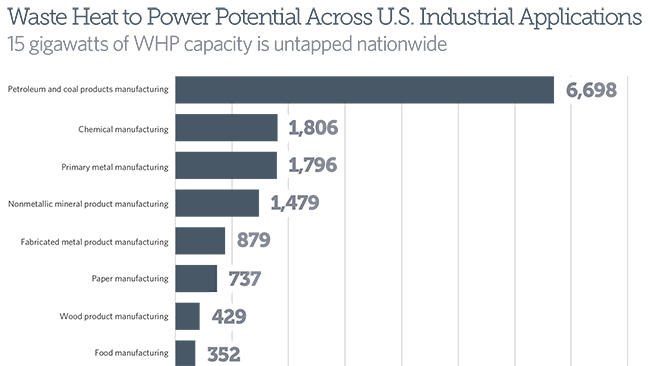Energy Efficiency Offers Opportunity for American Industrial Sector
High potential to save money and increase competitiveness
Note: This page has been updated with new resources following the June 24 webinar.
Every industrial process that involves transforming raw materials into useful products—including the work of steel mills, refineries, chemical plants, oil and gas pipelines, and general manufacturing—generates heat as a byproduct of operations.1 The industrial sector is responsible for about a third of the energy consumed in the United States, and 20 to 50 percent of the fuel used for generation is lost as waste heat. The idea of capturing this unused thermal resource to produce electricity is not new, but it is often overlooked.
The key advantage of waste heat to power (WHP) is that it uses heat from existing processes, which would otherwise be wasted, to produce electricity or mechanical power without additional fuel or incremental emissions—dramatically lowering energy use, total emissions, and costs.2
To date, 766 megawatts of WHP capacity is installed across the U.S. Of this, 87 percent is found in the chemical, refining, primary metals, and pipeline transportation industries.3 A recent report from the Department of Energy noted that the U.S. industrial sector has the opportunity to capture and convert to electricity 15 gigawatts of heat that is being wasted at more than 2,900 factories, plants, and other facilities, but only half of this potential has been deployed. The analysis shows great opportunity for further adoption across the country.
Texas, California, and Louisiana lead the nation in potential for WHP installations, accounting for a possible 3.2 GW combined. The study assessed 21 manufacturing sectors for their technical and economic potential for converting waste heat to electricity and found that in the petroleum and coal products manufacturing industry alone, almost 6.7 GW of capacity is currently unrealized. Chemical, primary metal, and nonmetallic mineral product manufacturing is second, with a cumulative potential of slightly more than 5 GW.
Despite the significant potential, regulatory barriers continue to stifle adoption. The investment tax credit (ITC) applies to other technologies that capture and use wasted heat, but WHP is not eligible. This lack of tax policy parity deters companies from making capital investments in and impedes the widespread deployment of WHP.
Recently, Congress took steps to ensure equal treatment for all industrial energy efficiency technologies with the bipartisan introduction of the Power Efficiency and Resiliency (POWER) Act. Proposed in both the House (H.R. 2657) and the Senate (S. 1516), the legislation would amend the ITC to give WHP and combined heat and power (CHP)—another industrial efficiency technology—equal standing with solar and fuel cells under the tax credit. These changes would reduce the initial capital cost of installing WHP and CHP projects, spurring investment in these energy-saving units. Extending the tax credit to include WHP would encourage developers to take advantage of the thousands of unrealized megawatts of potential. Flexible incentives would mean more U.S. companies could install these systems, making some of the largest power users more efficient, productive, and competitive.
Waste Heat to Power Market Assessment Webinar
On June 24, Pew and the Heat is Power Association held a webinar introducing the Waste Heat to Power Market Assessment, a recent report by ICF International for the U.S. Department of Energy’s Oak Ridge National Laboratory. The webinar highlighted key findings, methodology, and next steps from the report and included additional information about WHP initiatives at the Department of Energy, the Heat is Power Association, and Pew.
Endnotes
- “About Waste Heat,” Heat is Power Association, http://www.heatispower.org/waste-heat-to-power.
- U.S. Environmental Protection Agency Combined Heat and Power Partnership, “Waste Heat to Power Systems” (May 18, 2012), http://www.heatispower.org/wp-content/uploads/2012/06/EPA-waste_heat_power-report-5.2012.pdf.
- ICF International, Waste Heat to Power Market Assessment, Oak Ridge National Laboratory (March 2015), http://info.ornl.gov/sites/publications/Files/Pub52953.pdf.







